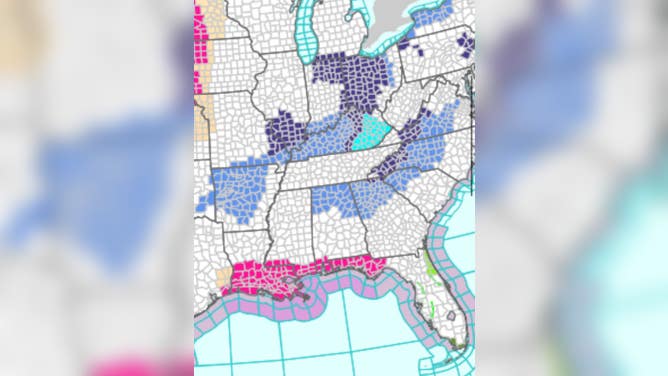Why you’ll see fewer winter alerts on the weather maps this year
The National Weather Service has 122 offices across the 50 states, Puerto Rico and Guam, with each responsible for the official forecast for the local counties that fall under their jurisdiction. The agency is divided into six regions, with the central U.S. having the most forecast offices.
FOX Weather Winter Storm HQ Minute: Is Winter Weather Worse Than Severe?
FOX Weather Winter Storm Specialist Tom Niziol breaks down why winter weather is so dangerous.
NASHVILLE – Weather enthusiasts who closely monitor weather maps may notice that the state of Tennessee is not highlighted as frequently as its neighboring states for frosts and freezes. This change is not due to any data outage or the state somehow controlling temperatures to remain warmer than its neighbors, but rather to internal adjustments made by the National Weather Service (NWS) offices serving the Tennessee Valley.
Leaders in NWS offices around Knoxville, Nashville, Memphis and Huntsville have come to an operating standard that says its meteorologists will not issue Frost Advisories or Freeze Watches and Warnings past Sept. 30 in a calendar year and not before May 1 during the start of a new year.
Freeze Warnings and Watches are typically issued when temperatures are expected to drop near or below 32 degrees Fahrenheit, which causes damage to plants and agriculture.
Most NWS offices across the U.S. operate under the criteria that they’ll issue these winter weather products until the growing season is over, but there’s apparently a change in thinking regarding how useful these products are around the end of the growing season and the start of the next.
"This change should reduce or alleviate the confusion each spring and fall when these products are issued or not issued. By standardizing the dates for issuing these products, we can reduce inconsistencies in messaging to stakeholders," the NWS office in Memphis stated.

Weather alert map showing Freeze Watches and Warnings issued for states around Tennessee
WIND CHILL, OTHER COLD WEATHER ALERTS TO GET NEW NAMES THIS WINTER FROM NATIONAL WEATHER SERVICE
The end and start of growing seasons vary dramatically by climate and geographic location. A locale in Florida may never exit the growing season due to its typical tropical climate, while communities along the U.S.-Canadian border may have only five or six viable months for growing and harvesting plants.
As a result, NWS offices in Minneapolis, Milwaukee or Buffalo are much more likely to discontinue these products for the season weeks or even months earlier than offices such as Tallahassee, Mobile or the Atlanta metro area, which have a longer time to tend to crops before the first significant winter cooldown.
The establishment of start and end dates by offices serving Tennessee is not part of the agency’s nationwide Hazard Simplification project, which has eliminated a variety of warnings including Wind Chill alerts and Hard Freeze Watches and Warnings.
This winter, communities will instead be put under Cold Weather Advisories, Extreme Cold Watches and Extreme Cold Warnings, which will alert counties about dangerously cold conditions.
The weather service says that these planned nationwide changes aim to address common misconceptions that extreme cold is solely the result of windy days and that communities are in the clear after a heavy snowfall or ice event.
NATIONAL WEATHER SERVICE REVAMPS FLOOD ALERTS
According to government forecasters, they wouldn’t be surprised if more regions of the country jump on the Tennessee bandwagon and change the criteria for when Freeze alerts and Frost Advisories are issued during a year.
Local meteorologists report that reactions to the changes have been mixed, which is often the case whenever a product undergoes modification.
Additionally, the four forecast offices that serve the Volunteer State do not issue tropical weather alerts such as Tropical Storm Watches and Warnings or Hurricane Watches and Warnings.
This was recently seen during the recent Helene disaster, which brought tropical storm conditions as far north as the Ohio Valley.
Meteorologists at the NWS Knoxville office said that when the criteria for a tropical cyclone is met, they, along with their three counterpart offices, issue what is known as a High Wind Warning, which communicates the dangers associated with windy conditions.
The NWS has 122 offices across the 50 states, Puerto Rico and Guam, each responsible for the official forecasts for the local counties within their jurisdiction.
